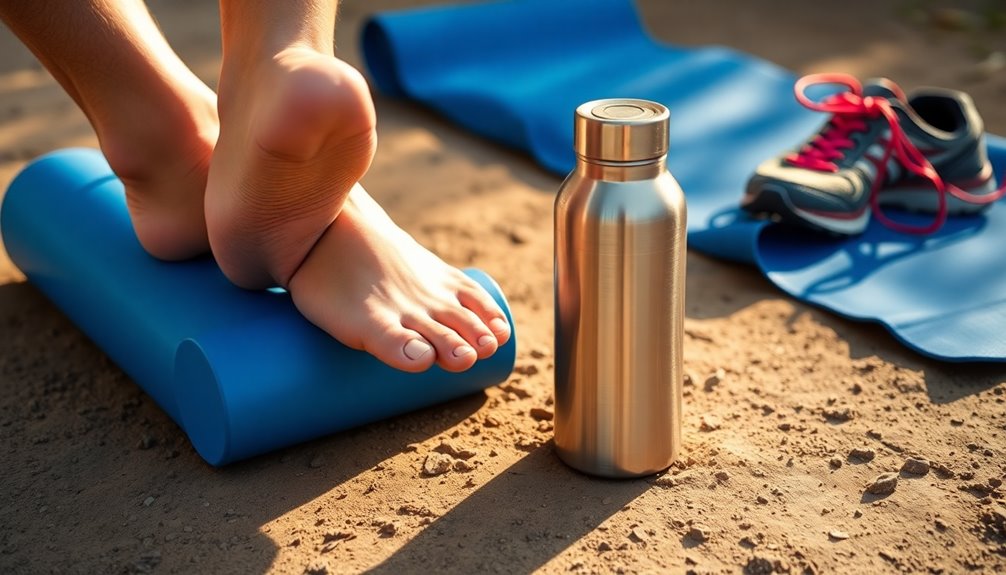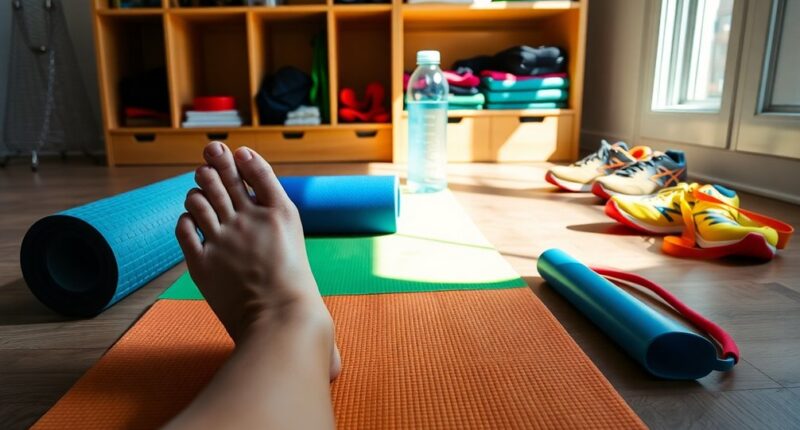To prevent injuries as a runner, invest in quality shoes, slowly increase your mileage by no more than 10% weekly, and incorporate strength training and stretching into your routine. Focus on recovery by refueling with carbs and protein post-run, staying hydrated, and getting enough sleep. Regularly replace your running shoes and consider custom orthotics if needed. With these essential practices, you can enhance both your performance and longevity in running—there's more to explore on maximizing your training!
Key Takeaways
- Invest in quality running shoes and conduct a gait analysis to enhance support and reduce injury risk.
- Follow the 10% rule for gradual mileage increases to allow your body to adapt safely.
- Incorporate strength training and flexibility exercises to improve core stability and prevent injuries.
- Prioritize post-run nutrition with carbohydrates and protein to aid recovery and muscle repair.
- Utilize foam rolling and ensure adequate sleep for enhanced recovery and reduced muscle soreness.
Understanding Common Running Injuries

When you hit the pavement, understanding common running injuries can help you stay on track and enjoy your runs. Many runners face issues like runner's knee, Achilles tendonitis, hamstring strains, plantar fasciitis, and shin splints, often stemming from overuse or improper running form.
The high-impact nature of running subjects your joints and muscles to forces that can lead to wear and tear over time. About 40-50% of runners experience injuries annually, making injury prevention essential.
Incorporating dynamic stretches into your training program and allowing adequate recovery time can greatly reduce risks. Regularly monitoring your running form and addressing pain early can prevent chronic injuries.
Consider consulting physical therapists for tailored advice and techniques like foam rolling to enhance your recovery.
Key Strategies for Injury Prevention

To stay injury-free while running, it's crucial to implement key strategies that prioritize your body's needs.
Start by investing in quality running shoes that offer the support and cushioning necessary to reduce injury risk.
Follow the 10% rule for a gradual increase in mileage, allowing your body to adapt safely.
Incorporate strength training focused on your core and legs to enhance stability and joint support.
Don't forget to engage in flexibility and mobility exercises, like dynamic stretching before and static stretching after your runs.
Regularly use foam rollers for myofascial release to alleviate muscle tension and promote recovery.
Finally, consider a gait analysis to identify any biomechanical issues that could lead to injuries.
Effective Recovery Techniques for Runners

Effective recovery techniques are crucial for runners looking to enhance their performance and minimize the risk of injury.
Refueling with a mix of carbohydrates and protein within 30-60 minutes post-workout boosts recovery and replenishes glycogen.
Incorporate static stretching after your runs; holding each stretch for 20-30 seconds improves flexibility and helps prevent muscle tightness. Additionally, integrating an ancient Chinese breathing technique can enhance your post-run routine by promoting relaxation and improving oxygen flow to your muscles. Focus on deep, rhythmic breaths as you stretch; this not only aids in recovery but also reduces stress and helps you feel rejuvenated for your next workout.
Don't forget the power of foam rolling; it alleviates tension and promotes blood flow, reducing muscle soreness.
Prioritize sleep, aiming for 7.5 to 8 hours a night to improve recovery and overall athletic performance.
Finally, consider therapeutic modalities like Normatec Compression Therapy to enhance recovery by boosting blood flow.
These techniques are crucial for injury prevention and fostering strength and stability in your running routine.
Importance of Proper Footwear and Equipment

Recovery techniques are only part of the equation for injury prevention. Choosing proper footwear plays a crucial role in keeping you injury-free.
Here's what to take into account:
- Visit a specialty running store for a gait analysis to find shoes that match your foot mechanics.
- Look for running shoes with adequate cushioning to reduce the risk of overuse injuries like plantar fasciitis and runner's knee.
- Replace your shoes every 300-400 miles to maintain ideal support.
- Think about customized orthotics if you have specific foot issues, enhancing your running biomechanics.
Additionally, selecting shoes that cater to your foot type can significantly improve your overall running experience and prevent overuse injuries.
Essential Nutrition and Hydration Practices

While you might focus on your training regimen, don't underestimate the impact of fundamental nutrition and hydration practices on your running performance.
Refueling with a mix of carbohydrates and protein within 30-60 minutes post-workout enhances muscle repair and replenishes glycogen stores. Hydration is critical; drink water before, during, and after your runs to prevent dehydration and maintain peak performance.
Aim for 7.5 to 8 hours of sleep each night, increasing by one minute for each mile you train weekly, as quality sleep is essential for recovery. Consuming carbohydrates before and after long runs greatly boosts energy levels and aids recovery.
Regularly monitor your hydration levels throughout the week to guarantee a proper fluid balance, important for your overall health and training success. Including fresh fruit juice in your diet can provide essential vitamins and minerals to support your recovery.
Frequently Asked Questions
What Is the Best Exercise for Injured Runners?
The best exercise for you as an injured runner often depends on your specific injury.
Low-impact activities like swimming or cycling can help maintain your cardiovascular fitness without putting stress on your injury.
Strength training for your core and legs can stabilize your joints, while flexibility exercises can improve your range of motion.
Don't forget to consult a healthcare provider for personalized recommendations that will suit your recovery goals and keep you on track.
How Do Runners Stay Injury Free?
To stay injury-free, you've got to be smart about your training.
Gradually increase your mileage by no more than 10% each week. Incorporate strength training to build stability, and don't skip your dynamic warm-ups before runs.
Invest in proper footwear that suits your running style, and stick to recovery practices like foam rolling and static stretching after each run.
These steps will help keep you on track and enjoying your runs!
What Is the Most Common Runner's Injury?
Imagine this: you're cruising down the track like a gazelle, but suddenly, that nagging pain hits.
The most common runner's injury is runner's knee, or patellofemoral pain syndrome. It affects about 25% of runners at some point. This pain typically arises from overuse, improper form, or muscle imbalances.
If you want to keep running strong, it's essential to pay attention to your body and address any discomfort early on.
How Does a Running Shoe Protect You From Injury?
A running shoe protects you from injury by providing essential cushioning that absorbs impact forces with each step. This reduces stress on your joints and muscles, helping to prevent issues like runner's knee or shin splints.
Quality footwear also offers stability and support, maintaining proper foot alignment. By choosing shoes that match your foot type and replacing them regularly, you enhance comfort and efficiency, ultimately lowering your risk of injury during your runs.
Conclusion
You've learned the essentials of injury prevention and recovery, but the journey doesn't end here. Each run carries a risk, and every step you take could lead to unforeseen challenges. Will you heed the strategies and practices shared, or will you find yourself sidelined by an avoidable injury? Remember, the difference between a fulfilling run and a painful setback lies in your choices. Stay proactive, listen to your body, and embrace the path to resilience. Your running future awaits.









